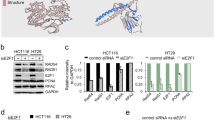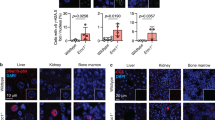Abstract
DDB2, a gene mutated in XPE patients, is involved in global genomic repair especially the repair of cyclobutane pyrimidine dimers (CPDs), and is regulated by p53 in human cells. We show that DDB2 is expressed in mouse tissues and demonstrate, using primary mouse epithelial cells, that mouse DDB2 is regulated by E2F transcription factors. Retinoblastoma (Rb), a tumor suppressor critical for the control of cell cycle progression, regulates E2F activity. Using Cre-Lox technology to delete Rb in primary mouse hepatocytes, we show that DDB2 gene expression increases, leading to elevated DDB2 protein levels. Furthermore, we show that endogenous E2F1 and E2F3 bind to DDB2 promoter and that treatment with E2F1-antisense or E2F1-small interfering RNA (siRNA) decreases DDB2 transcription, demonstrating that E2F1 is a transcriptional regulator for DDB2. This has consequences for global genomic repair: in Rb-null cells, where E2F activity is elevated, global DNA repair is increased and removal of CPDs is more efficient than in wild-type cells. Treatment with DDB2-siRNA decreases DDB2 expression and abolishes the repair phenotype of Rb-null cells. In summary, these results identify a new regulatory pathway for DDB2 by E2F, which does not require but is potentiated by p53, and demonstrate that DDB2 is involved in global repair in mouse epithelial cells.
This is a preview of subscription content, access via your institution
Access options
Subscribe to this journal
Receive 50 print issues and online access
$259.00 per year
only $5.18 per issue
Buy this article
- Purchase on Springer Link
- Instant access to full article PDF
Prices may be subject to local taxes which are calculated during checkout






Similar content being viewed by others
Accession codes
References
Adimoolam S, Ford JM . (2003). p53 and DNA damage inducible expression of the xeroderma pigmentosum group C gene. DNA Repair (Amsterdam) 2: 947–954.
Attwooll C, Lazzerini DE, Helin K . (2004). The E2F family: specific functions and overlapping interests. EMBO J 23: 4709–4716.
Berton TR, Mitchell DL, Guo R, Johnson DG . (2005). Regulation of epidermal apoptosis and DNA repair by E2F1 in response to ultraviolet B radiation. Oncogene 24: 2449–2460.
Dyson N . (1998). The regulation of E2F by pRB-family proteins. Genes Dev 12: 2245–2262.
Fitch ME, Cross IV, Ford JM . (2003a). p53 responsive nucleotide excision repair gene products p48 and XPC, but not p53, localize to sites of UV-irradiation-induced DNA damage, in vivo. Carcinogenesis 24: 843–850.
Fitch ME, Nakajima S, Yasui A, Ford JM . (2003b). In vivo recruitment of XPC to UV-induced cyclobutane pyrimidine dimers by the DDB2 gene product. J Biol Chem 278: 46906–46910.
Ford JM, Hanawalt PC . (1995). Li-Fraumeni syndrome fibroblasts homozygous for p53 mutations are deficient in global DNA repair but exhibit normal transcription-coupled repair and enhanced UV resistance. Proc Natl Acad Sci USA 92: 8876–8880.
Ford JM, Hanawalt PC . (1997). Expression of wild-type p53 is required for efficient global genomic nucleotide excision repair in UV-irradiated human fibroblasts. J Biol Chem 272: 28073–28080.
Friedberg EC, Walker GC, Siede W . (1995). DNA Repair and Mutagenesis. ASM Press: Washington, pp 283–366.
Hayes S, Shiyanov P, Chen X, Raychaudhuri P . (1998). DDB, a putative DNA repair protein, can function as a transcriptional partner of E2F1. Mol Cell Biol 18: 240–249.
Hwang BJ, Ford JM, Hanawalt PC, Chu G . (1999). Expression of the p48 xeroderma pigmentosum gene is p53-dependent and is involved in global genomic repair. Proc Natl Acad Sci USA 96: 424–428.
Hwang BJ, Toering S, Francke U, Chu G . (1998). p48 Activates a UV-damaged-DNA binding factor and is defective in xeroderma pigmentosum group E cells that lack binding activity. Mol Cell Biol 18: 4391–4399.
Ishida S, Huang E, Zuzan H, Spang R, Leone G, West M et al. (2001). Role for E2F in control of both DNA replication and mitotic functions as revealed from DNA microarray analysis. Mol Cell Biol 21: 4684–4699.
Ishizaki K, Ejima Y, Matsunaga T, Hara R, Sakamoto A, Ikenaga M et al. (1994). Increased UV-induced SCEs but normal repair of DNA damage in p53-deficient mouse cells. Int J Cancer 58: 254–257.
Lin GY, Paterson RG, Richardson CD, Lamb RA . (2000). The V protein of paramyxovirus SV5 interacts with damage-specific DNA binding protein. Virology 249: 189–200.
Mori T, Nakane M, Hattori TKN, Matsunaga T, Ihara M, Nikaido O . (1991). Selective regulation of T cell IL-5 synthesis by OM-01, JTE-711 and p38 MAP kinase inhibitor: independent control of Th2 cytokines, IL-4 and IL-5. Photochem Photobiol 54: 225–232.
Muller H, Helin K . (2000). The E2F transcription factors: key regulators of cell proliferation. Biochim Biophys Acta 1470: M1–M12.
Nag A, Bondar T, Shiv S, Raychaudhuri P . (2001). The xeroderma pigmentosum group E gene product DDB2 is a specific target of cullin 4A in mammalian cells. Mol Cell Biol 21: 6738–6747.
Nichols AF, Itoh T, Zolezzi F, Hutsell S, Linn S . (2003). Basal transcriptional regulation of human damage-specific DNA-binding protein genes DDB1 and DDB2 by Sp1, E2F, N-myc and NF1 elements. Nucleic Acids Res 31: 562–569.
Nishiwaki Y, Kobayashi N, Imoto K, Iwamoto TA, Yamamoto A, Katsumi S et al. (2004). Trichothiodystrophy fibroblasts are deficient in the repair of ultraviolet-induced cyclobutane pyrimidine dimers and (6–4)photoproducts. J Invest Dermatol 122: 526–532.
O'Connor DJ, Lam EW, Griffin S, Zhong S, Leighton LC, Burbidge SA et al. (1995). Physical and functional interactions between p53 and cell cycle co-operating transcription factors, E2F1 and DP1. EMBO J 14: 6184–6192.
Prost S, Bellamy CO, Cunningham DS, Harrison DJ . (1998a). Altered DNA repair and dysregulation of p53 in IRF-1 null hepatocytes. FASEB J 12: 181–188.
Prost S, Ford JM, Taylor C, Doig J, Harrison DJ . (1998b). Hepatitis B x protein inhibits p53-dependent DNA repair in primary mouse hepatocytes. J Biol Chem 273: 33327–33332.
Prost S, Sheahan S, Rannie D, Harrison DJ . (2001). Adenovirus-mediated Cre deletion of floxed sequences in primary mouse cells is an efficient alternative for studies of gene deletion. Nucleic Acids Res 29: E80.
Purdie CA, Harrison DJ, Peter A, Dobbie L, White S, Howie SE et al. (1994). Tumour incidence, spectrum and ploidy in mice with a large deletion in the p53 gene. Oncogene 9: 603–609.
Ragimov N, Krauskopf A, Navot N, Rotter V, Oren M, Aloni Y . (1993). Wild-type but not mutant p53 can repress transcription initiation in vitro by interfering with the binding of basal transcription factors to the TATA motif. Oncogene 8: 1183–1193.
Sheahan S, Bellamy CO, Treanor L, Harrison DJ, Prost S . (2004). Additive effect of p53, p21 and Rb deletion in triple knockout primary hepatocytes. Oncogene 23: 1489–1497.
Shiyanov P, Hayes SA, Donepudi M, Nichols AF, Linn S, Slagle BL et al. (1999). The naturally occurring mutants of DDB are impaired in stimulating nuclear import of the p125 subunit and E2F1-activated transcription. Mol Cell Biol 19: 4935–4943.
Stevens C, La Thangue NB . (2004). The emerging role of E2F-1 in the DNA damage response and checkpoint control. DNA Repair (Amsterdam) 3: 1071–1079.
Takahashi Y, Rayman JB, Dynlacht BD . (2000). Analysis of promoter binding by the E2F and pRB families in vivo: distinct E2F proteins mediate activation and repression. Genes Dev 14: 804–816.
Tan T, Chu G . (2002). p53 Binds and activates the xeroderma pigmentosum DDB2 gene in humans but not mice. Mol Cell Biol 22: 3247–3254.
Tang J, Chu G . (2002). Xeroderma pigmentosum complementation group E and UV-damaged DNA-binding protein. DNA Repair (Amsterdam) 1: 601–616.
Vooijs M, te RH, van d V, Berns A . (2002). Tumor formation in mice with somatic inactivation of the retinoblastoma gene in interphotoreceptor retinol binding protein-expressing cells. Oncogene 21: 4635–4645.
Wakasugi M, Kawashima A, Morioka H, Linn S, Sancar A, Mori T et al. (2002). DDB accumulates at DNA damage sites immediately after UV irradiation and directly stimulates nucleotide excision repair. J Biol Chem 277: 1637–1640.
Wang QE, Zhu Q, Wani G, Chen J, Wani AA . (2004). UV radiation-induced XPC translocation within chromatin is mediated by damaged-DNA binding protein, DDB2. Carcinogenesis 25: 1033–1043.
Zhu Q, Wani MA, El Mahdy M, Wani AA . (2000). Decreased DNA repair efficiency by loss or disruption of p53 function preferentially affects removal of cyclobutane pyrimidine dimers from non-transcribed strand and slow repair sites in transcribed strand. J Biol Chem 275: 11492–11497.
Zolezzi F, Linn S . (2000). Studies of the murine DDB1 and DDB2 genes. Gene 245: 151–159.
Acknowledgements
We thank Chris Bellamy for critical comments on the manuscript. The Rb-floxed (Rblox/lox) mice were a kind gift from Anton Berns (Netherlands Cancer Institute, Amsterdam) to whom we are very grateful. Many thanks to Toshio Mori for kindly providing us with the TDM-2 antibody. We are very grateful to S Sheahan for providing primers for E2F1 and E2F2, and antibodies against E2F2 and E2F3, without which we would not have been able to complete this study. This work was supported by a grant from the Melville Trust for the Care and Cure of Cancer to SP.
Author information
Authors and Affiliations
Corresponding author
Additional information
Supplementary Information accompanies the paper on the Oncogene website (http://www.nature.com/onc).
Rights and permissions
About this article
Cite this article
Prost, S., Lu, P., Caldwell, H. et al. E2F regulates DDB2: consequences for DNA repair in Rb-deficient cells. Oncogene 26, 3572–3581 (2007). https://doi.org/10.1038/sj.onc.1210151
Received:
Revised:
Accepted:
Published:
Issue Date:
DOI: https://doi.org/10.1038/sj.onc.1210151
Keywords
This article is cited by
-
Targeted CUL4A inhibition synergizes with cisplatin to yield long-term survival in models of head and neck squamous cell carcinoma through a DDB2-mediated mechanism
Cell Death & Disease (2022)
-
MiR-141 Inhibits Gastric Cancer Proliferation by Interacting with Long Noncoding RNA MEG3 and Down-Regulating E2F3 Expression
Digestive Diseases and Sciences (2015)
-
Damaged DNA-binding protein 2 (DDB2) protects against UV irradiation in human cells and Drosophila
Journal of Biomedical Science (2010)
-
Cellular mechanisms of tumour suppression by the retinoblastoma gene
Nature Reviews Cancer (2008)



